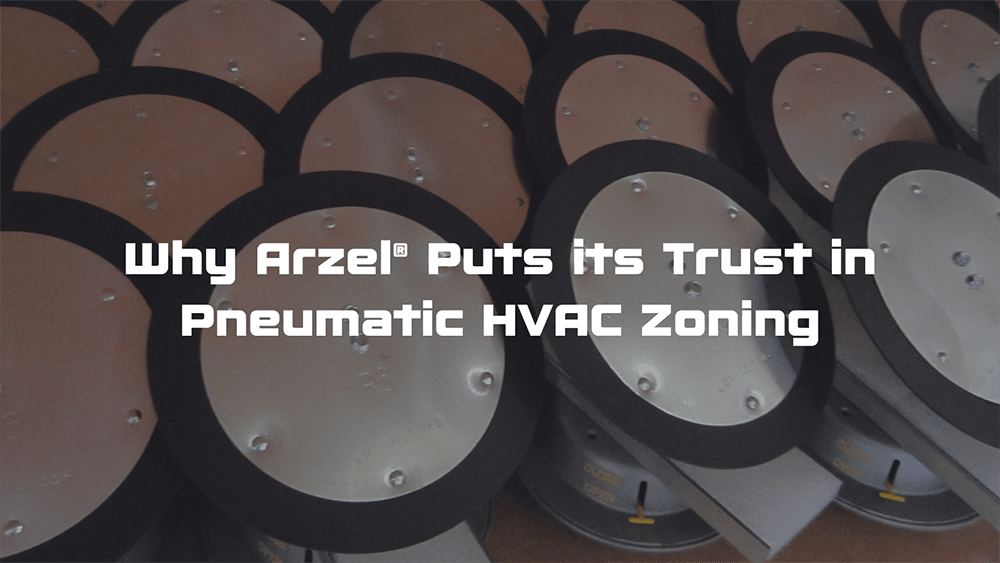
For homeowners and businesses alike, finding the most effective way to heat and cool their property is essential. That’s why Arzel® is trusting in pneumatic zoning—an air-driven zoning technology to control the temperature in different parts of the home or building. This blog post will explore why Arzel® is confident in this air-driven zoning technology.
Some technicians will ask, “Why Pneumatic?” when zoning a central heating and cooling system. The image in their minds is commercial systems that use high-pressure airlines and air-driven thermostats, commonly found in hospitals. Some technicians think of these pneumatic systems as old-fashioned or “old school.” Others think they are a pain to service because of the large compressors that require specialty training.
However, Arzel® Zoning’s air-driven dampers are the core of our pneumatic zoning solutions. There’s no accurate comparison in answering the question of Arzel® low pneumatic vs. motorized vs. high-pressure pneumatics. It’s apples to oranges.
Arzel® dampers provide flexibility and reliability. Instead of complex gears, a bladder inflates and deflates based on vacuum or pressure. With fewer moving parts, there is less potential for failure, providing outstanding reliability.
Our small air cylinders fit places that mechanical gearing doesn’t. Our unique fit dampers, the EzyFit® and Inserta®, can be installed where traditional motor-driven actuators can’t. That makes Arzel® the best choice for retrofit zoning.
The ability to zone what was before impossible creates additional revenue streams and a competitive advantage. There’s also less mess in your customers’ homes because necessity of cutting drywall to install traditional zoning is reduced, often eliminated. Without expensive home remodeling, traditional zoning would be a tough sell. With Arzel, it is an easier proposal.
The simplicity of our air-driven solutions means you won’t need specialty tools. Technicians can use common tools on their trucks today. Low pressure can easily be diagnosed with a digital manometer that reads at least 40″ w.c. +/-. The low-pressure airlines are a simple barbed compression fit that doesn’t require anything other than fingers (no glue or solvents, no thread sealant, nothing messy).
The simple airlines are faster, cheaper, and easier to install than the copper lines typical of the high-pressure pneumatic system. They have the same benefits compared to the low-voltage cabling of traditional zoning systems.
Flexibility also means more dampers with less hassle – Each stock Arzel® panel can support up to 35 actuators spread across two zones, three zones, etc. Arzel panels can support up to eight zones, but contractors should avoid micro or small zones. Read more on why we don’t recommend micro zoning in a previous blog: What Is the Big Problem with Tiny Zones?
24vac panels, on the other hand, require relay panels to support that number of dampers and beefy transformers.
Additionally, unlike traditional pneumatic systems, you won’t need a specialty thermostat. The standard 24-volt thermostats that technicians already stock on their trucks will do, so you won’t need additional truck stock.
Pneumatic zoning is one of the most reliable HVAC zoning technologies available, and it offers several benefits to anyone looking to optimize their heating and cooling system. To recap, pneumatic zoning, specifically the low-pressure pneumatics that Arzel® offers, provides the following benefits:
Pneumatic zoning is not old-fashioned or complex. It is the solution to simple or complicated ducting, along with finished and unfinished basements. These benefits for contractors and homeowners are why we trust pneumatic technology.
Any HVAC professional will tell you that multi-stage equipment is great. These powerful air conditioning machines can achieve better comfort and better energy efficiency. We wanted to take a moment to explain why HVAC zoning makes multi-stage equipment even better. Here’s how we’re optimizing multi-stage equipment with Arzel Zoning. Why would you zone multi-stage equipment? […]
There’s been a big change in HVAC this year with the introduction of A2L refrigerants. By now, most of our customers have done some kind of training on R-32 or R-454B refrigerant. The new class of refrigerants does have some impacts on zoning. Here’s what you need to know about HVAC zoning with A2L refrigerants. […]
So you’re ready to install zoning in your customer’s home or business. Congratulations! Let’s make the next part as easy as possible, with this advice on getting your HVAC zoning system kit. Components of a zoning system kit There are just five parts you’ll need to install an Arzel Zoning system. A zoning panel Zoning […]
Can you add zones to an existing HVAC system? Yes! Arzel Zoning has been doing exactly that for more than 40 years. Our retrofit zoning options make it as seamless as possible. Here’s how it works. Why would clients want more than one zone? Let’s start with why a home or business owner would want […]